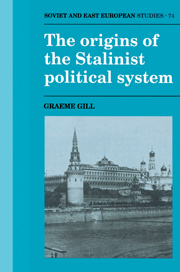Book contents
- Frontmatter
- Contents
- Preface
- Abbreviations
- Introduction: What is Stalinism?
- PART I COHESIVE OLIGARCHY 1917–1922
- PART II THE FRACTURED OLIGARCHY 1922–1929
- 3 A strong party structure?
- 4 The divided elite
- Part III THE RE-FORMED OLIGARCHY, 1930–1934
- PART IV THE OLIGARCHY SUBDUED, 1935–1941
- Conclusion: Why Stalinism?
- Notes
- Bibliography
- Index
- Soviet and East European Studies
3 - A strong party structure?
Published online by Cambridge University Press: 11 September 2009
- Frontmatter
- Contents
- Preface
- Abbreviations
- Introduction: What is Stalinism?
- PART I COHESIVE OLIGARCHY 1917–1922
- PART II THE FRACTURED OLIGARCHY 1922–1929
- 3 A strong party structure?
- 4 The divided elite
- Part III THE RE-FORMED OLIGARCHY, 1930–1934
- PART IV THE OLIGARCHY SUBDUED, 1935–1941
- Conclusion: Why Stalinism?
- Notes
- Bibliography
- Index
- Soviet and East European Studies
Summary
The 1920s was a period of considerable freedom and plurality within Soviet society. Following the rigours of War Communism, the policies associated with the NEP had led to a discernible easing of the political atmosphere; class war rhetoric and the politics of class struggle gave way to a policy of class conciliation as the regime sought to reach a more amicable modus vivendi with the populace. But despite this less overtly antagonistic relationship between regime and populace, a sense of insecurity continued to pervade large parts of the political structure. Despite the elimination of opposition parties as effective entities and the smashing of the two major instances of organised opposition to emerge during this period, the Workers' Group and the Workers' Truth, the control exercised by the party throughout the country was not firmly rooted. Two aspects of this were significant: the isolation of the party from society at large and the internal structuring of party life.
The party's isolation is graphically shown by the weakness of its representation in rural areas. According to figures cited by Stalin at the XIII Congress, the proportion of communists in organisations at each level of the soviet hierarchy was as follows: village soviets 7 per cent, executive committees of volost soviets 48 per cent, executive committees of uezd soviets 87 per cent and executive committees of guberniia soviets 89 per cent. Another speaker at the same congress declared that in three to four volosts with 50 to 60 thousand villages, there were only ten communists; according to the Smolensk Archive, there was only one party member for every ten villages.
- Type
- Chapter
- Information
- The Origins of the Stalinist Political System , pp. 113 - 134Publisher: Cambridge University PressPrint publication year: 1990

